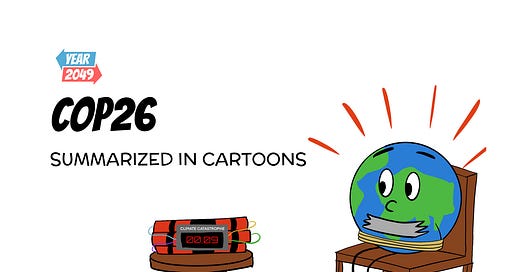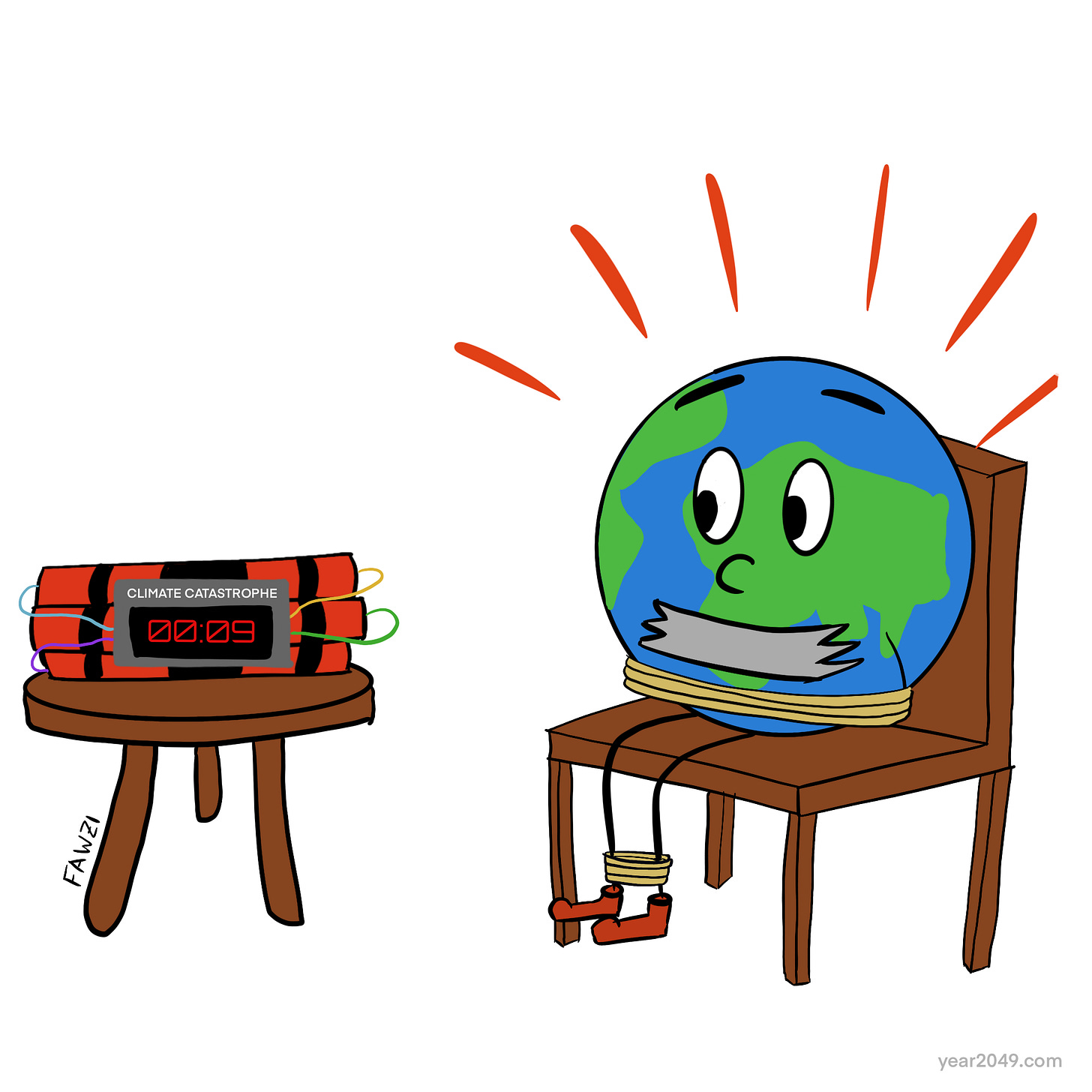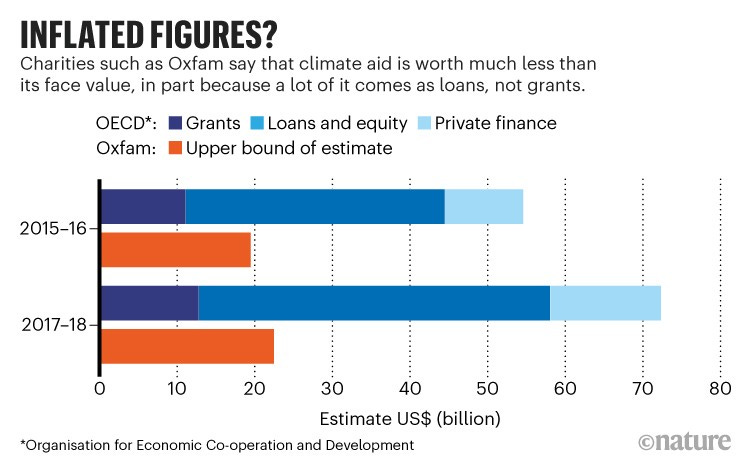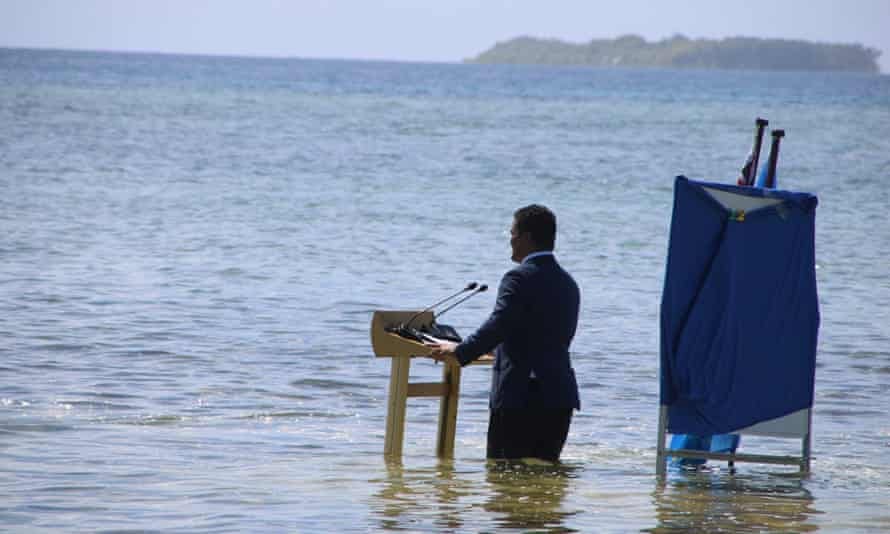Welcome to a new episode of Year 2049, your weekly guide to the events, discoveries, and innovations shaping the future of tech, climate, science, and more.
If this was forwarded to you, subscribe to get a new story in your inbox every Friday 👇
Happy Friday!
I have a special edition for you this week.
I was overwhelmed by the flurry of news and announcements that came out of the COP26 climate summit. There was too much to keep up with.
To make things easier for you and me, I spent the past week digging through all the articles and announcements to give you the main highlights, accompanied by a new style of cartoons I wanted to try out.
Hope you enjoy this one.
What’s COP26 and why should you care?
The COP, which stands for “conference of parties”, is an annual summit that brings together world leaders and delegations to discuss how they’re going to tackle the worsening climate crisis. This year marked the 26th installment of this meeting, which was held in Glasgow, Scotland.
COP26 was focused on accomplishing the following goals:
Mitigation: Cutting global emissions by 45% by 2030 and securing global net-zero emissions by 2050 to keep global warming under 1.5 degrees compared to pre-Industrial times. This requires countries to set strict emission targets, also known as “Nationally Determined Contributions”, or NDCs for short.
Adaptation: Protecting communities and natural habitats from the impacts of climate change. This includes deploying nature-based solutions (forests, agriculture, ecosystems) to absorb carbon and protect against extreme weather events.
Finance: Unleashing public and private financing to completely transition to a greener economy and achieve net-zero by 2050. This also involves offering financial support to developing countries, which are the most vulnerable to climate change.
Collaboration: Solving the climate crisis will require everyone working together, without exceptions. This involves finalizing the “Paris Rulebook”, which dictates the rules to implement the Paris Agreement including carbon markets (explained further down) and transparent reporting of emissions.
💣 The climate crisis is a ticking time bomb
UK Prime Minister Boris Johnson kicked off COP26 with his opening address. He compared the current climate situation to a ticking time bomb and we’re the “James Bond” that must defuse it. Maybe someone should tell him how the last James Bond movie ended?
“It’s one minute to midnight on the doomsday clock and we need to act now. If we don’t get serious about climate change today, it will be too late for our children to get serious about it tomorrow.”
– Boris Johnson, COP26 opening address
Following Johnson’s optimistic speech, UN Secretary-General António Guterres warned against climate optimism and that the climate situation wasn’t improving.
🎥 Watch Boris Johnson’s full opening address
🌲 Countries agree to end deforestation by 2030
141 countries committed to halting and reversing forest loss and land degradation by 2030 under the Glasgow Leaders’ Declaration on Forest and Land Use. They collectively cover 90% of the world’s existing forests.
The most notable endorser is Brazil, home of the Amazon rainforest which is reaching a catastrophic “tipping point” according to research from the Science Panel for the Amazon (SPA).
Further reading:
🔗 Read the full declaration here
🔗 Read more about the SPA’s study
⚖️ Developing countries demand climate justice
Climate justice is a movement to counter the unequal and unfair consequences of the climate crisis on certain countries. According to research from Oxfam:
The poorest 50% of the world are the most vulnerable to the effects of climate change, while only being responsible for 7% of global emissions between 1990 and 2015
The world’s richest 10% is responsible for more than 50% of global emissions
Since 1751, the US and European countries generated 47% of the world’s total carbon emissions while Africa and South America only produced 6%
Sub-Saharan Africa, which is responsible for less than 1% of global emissions, will likely suffer the most from climate change
Developing countries are urging rich countries to pay for their mistakes, as they should. Back in 2009, developing countries were promised $100 billion/year until 2020 to help mitigate the effects of climate change. Not only did rich countries fail to provide the full amount each year, but most of their funds were in the form of loans that need to be paid back.
Talk about the worst deal in the history deals.
Further reading:
🔗 What did African leaders call for at COP26’s opening ceremony?
🔗 The broken $100-billion promise of climate finance — and how to fix it
⛽️ Fossil fuels targeted for the first time
For the first time in the 26 COP summits that have ever occurred, fossil fuels have been called out in the main agreement.
One of the 84 lines of the agreement reads:
[The Conference of the Parties serving as the meeting of the Parties to the Paris Agreement] Calls upon Parties to accelerate the phasing-out of coal and subsidies for fossil fuels
My first thought was that phasing out subsidies ≠ phasing out fossil fuels.
But data from the International Institute for Sustainable Development suggests that it can have a monumental impact. Every year, $472 billion in subsidies is provided to the fossil fuel industry according to the IMF, and removing them can significantly reduce emissions in certain countries:
Further reading:
🔗 Why fossil fuels subsidies are so hard to kill
🤝 Deal reached for carbon markets
A deal to standardize an international carbon trading market was one of the biggest highlights of COP26. Carbon markets are one of the core components of the “Paris Rulebook”.
What’s a carbon market? It allows countries to buy and sell “carbon credits” to meet their emissions goals.
What’s a carbon credit? It represents 1 ton of CO2 removed from the atmosphere. The trading of carbon credits is based on the fact that CO2 emitted anywhere in the world has the same impact.
For example:
Country A is limiting its emissions below its targets
Country B is exceeding its emissions targets
Country B can buy carbon credits from Country A to increase its allowed “cap” of emissions
Carbon trading is a highly debated topic. Supporters of it say it can accelerate and incentivize the financing of projects to reduce or absorb greenhouse gases from the air. Opposers say it allows major polluters to pay their way out of reducing their emissions.
As you can tell from my cartoon, I’m more skeptical about carbon trading. But I genuinely hope it’s implemented properly because it could solve a lot of problems.
Further reading:
Other things
There was a lot to cover so here are a few extra things to know about:
100+ countries agreed to reduce methane emissions by 2030. Methane has 80 times the warming power of CO2 in the first 20 years after it reaches the atmosphere.
40+ countries agreed to phase out coal, one of the biggest emitters of CO2.
100 national governments, cities, states, and major businesses signed an agreement to end the worldwide sale of vehicles with internal combustion engines by 2040.
Wealthy countries didn’t support the creation of a “Loss and Damage” fund to compensate developing countries for damages, including loss of lives and land, sustained from climate impacts.
Overall, COP26 didn’t achieve its full potential or accomplish all its goals. UN Secretary-General António Guterres shared his feelings at the end of the 2-week summit:
“It is an important step but is not enough. We must accelerate climate action to keep alive the goal of limiting global temperature rise to 1.5 degrees”
World leaders and delegations will regroup again next year at COP27 in Egypt.
Final thoughts
Many of these pledges and promises seem promising at face value. But they’re still pledges and promises, so we’ll have to see if they’re followed by genuine action and desire to solve the climate crisis.
I’m skeptical about some commitments because it’s easy for some leaders to make a pledge for the next 10 or 30 years when they likely won’t be in office anymore and it’ll become someone else’s problem to solve.
But I prefer thinking more pragmatically. We have a world that depends so heavily on fossil fuels and we can’t eliminate our dependence on them overnight. Eliminating them can only be done through a phased approach over many years.
However, what must and can be done overnight is providing financing to the countries that are dealing with the life-altering impacts of climate change as we speak.
The image that left the biggest impact on me was Tuvalu’s foreign minister, Simon Kofe, delivering his speech knee-deep in seawater to show how his country is already struggling with rising sea levels.
What do you think?
What are your reactions and thoughts regarding the outcomes of COP26?
Leave a comment and let me know 👇
Help me spread the word ❤️
Doing the research, learning about new topics, drawing comics, and writing this newsletter has been an absolute joy for me every week.
This edition took 12 hours to make, so I would appreciate it if you took 1 minute to invite your family and friends to subscribe to Year 2049 and stay informed about the events, discoveries, and inventions shaping our future.
If you missed the previous episode
Next week
After reading today’s edition, you’re probably curious about climate change solutions so I’m explaining and sharing the latest on Carbon Capture technology next week!
Make sure you’re subscribed so you don’t miss it 👇
Much love,
Fawzi
How would you rate this week's edition?
















Very informative and easy to understand! It’s like we are having a conversation! And the cartoons are quite expressive! Enjoyed the post very much!